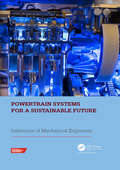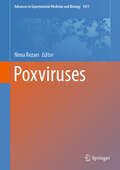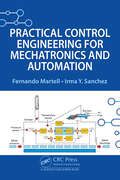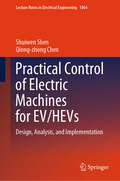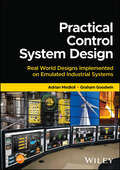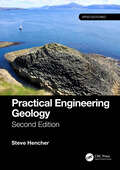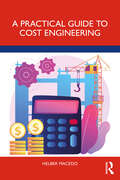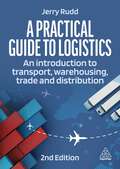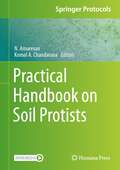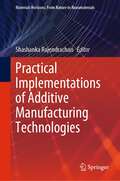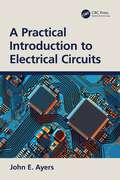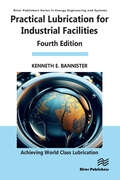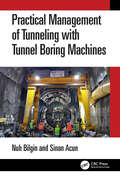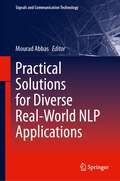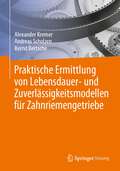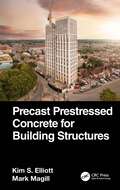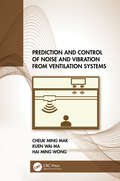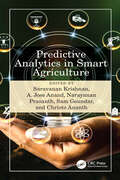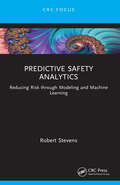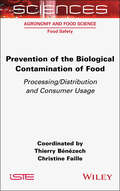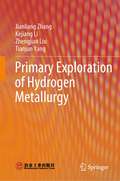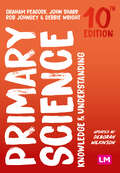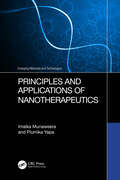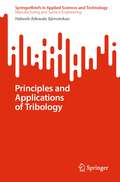- Table View
- List View
Powertrain Systems for a Sustainable Future: Proceedings of the International Conference on Powertrain Systems for a Sustainable Future 2023, London, UK, 29- 30 November 2023
by Institution of Mechanical EngineersThe transport sector continues to shift towards alternative powertrains, particularly with the UK Government’s focus on ending the sale of petrol and diesel passenger cars by 2030 and increasing support for alternatives. Despite this announcement, the internal combustion could continue to play a significant role both in the passenger car market through the use of hybrids and sustainable low carbon fuels including hydrogen, as well as a key role in other sectors such as heavy-duty vehicles and off-highway applications across the globe. The contributions presented at the International Conference on Powertrain Systems for a Sustainable Future 2023 (London, UK, 29- 30 November 2023) focus on the internal combustion engine’s role in net-zero transport as well as covering developments in the wide range of propulsion systems available (electric, hydrogen internal combustion engines and fuel cells, sustainable fuels etc) and their associated powertrains. To achieve a sustainable future for transport across the globe we will need to deploy all technologies and so, to help understand how these might fit together, life-cycle analysis of future powertrain systems and energy will also be included. Powertrain Systems for a Sustainable Future provides a forum for engine, fuels, e-machine, fuel cell and powertrain experts to look closely at developments in powertrain technology required to meet the demands of the net-zero future and global competition in all sectors of the road transportation, off-highway, marine and stationary power industries.
Poxviruses (Advances in Experimental Medicine and Biology #1451)
by Nima RezaeiSince the emergence of 2022’s monkeypox virus (MPXV) outbreak, it has been the heading of news and research articles that MPXV is being involving non-endemic areas after about its 80-year presence in endemic areas. Efforts are concentrated on understanding how MPXV has evolved to cause an epidemic. The book provides a comprehensive compendium of chapters on poxviruses in different domains. It concludes that the main problem we should deal with is not to address how MPXV has overcome the distance between non-endemic and endemic areas, but it is the non-cooperativity of logistics, research, and science in managing poxviruses’ outbreaks.
Practical Control Engineering for Mechatronics and Automation
by Fernando Martell Irma Y. SanchezProduction processes and engineered systems use continuous and discrete variables, as well as the combination of continuous and sequential operations. This volume covers both aspects, thus providing knowledge in continuous and discrete control, logic control, and hybrid control systems. It is a compilation of selected control strategies to automate processes and systems with a practical approach to ease their design, analysis and implementation. The selection of the control schemes is based on the capability to provide desired dynamical response or real time performance. Practicality is required for achieving faster development times of automation projects or system prototypes by comprehensive presentation and direct application of methodologies and techniques for efficient and structured programming of control algorithms. Considered methodologies include model-based design, hardware in the loop simulations and structured programming. Fundamental signals and systems concepts are explained. Systems and controllers are analyzed using discrete-time equations, which ease their implementation in most programmable platforms without requiring sophisticated software. PID based control, internal model control and model reference control are viewed as powerful schemes in terms of performance and suitability for mechatronics systems because of the use of the model in their architecture as a key control element. Finite state machines are presented to solve sequential requirements of direct and supervisory control of many processes and machines. Cyberphysical systems are an industrial technology and an education trend, distinguished by visual and dynamic models or digital twins of the physical systems. The discussed analysis, design and implementation practices are integrated and applied in the context of cyberphysical systems. This book aims to provide multidisciplinary support to engineers and practitioners in the design of control systems, and is a valuable tool for automation teaching and self-learning.
Practical Control of Electric Machines for EV/HEVs: Design, Analysis, and Implementation (Lecture Notes in Electrical Engineering #1064)
by Shuiwen Shen Qiong-zhong ChenUpon the ongoing profound revolution in the automotive industry, this book is primarily intended to give guidance on the practical design of traction motor control for pure electric vehicles (EVs) and hybrid electric vehicles (HEVs). An overview of the state-of-the-art motor types is provided to help understanding the background of automotive motor drives and the EV/HEV motor control specifications. Using AC induction motor control as a benchmark example, it addresses the motor control techniques by means of design, analysis, examples with MATLAB scripts wherever applicable, and practical control software architecture diagrams. In particular, an extensive analysis and discussion are made on the widely used vector control method together with multiple optimization schemes. As such, it gives coverage of the electric traction control including dynamics, efficiency, and the high-speed power capability, taking into account the constraints of vehicle configuration and requirements. The vector control and optimization strategies presented in this book can be ported across to other AC motor types without losing much generality. This book tries to bridge the gap between theory and practicality. Beginning with basic motor theory and completing the motor control design by introducing voltage source inverter (VSI) pulse width modulation (PWM) techniques, it helps the reader take a step-by-step approach from understanding fundamental motor characteristics through to practical design of in-depth motor control strategies.
Practical Control System Design: Real World Designs Implemented on Emulated Industrial Systems
by Adrian Medioli Graham GoodwinPractical Control System Design This book delivers real world experience covering full-scale industrial control design, for students and professional control engineers Inspired by the authors’ industrial experience in control, Practical Control System Design: Real World Designs Implemented on Emulated Industrial Systems captures that experience, along with the necessary background theory, to enable readers to acquire the tools and skills necessary to tackle real world control engineering design problems. The book draws upon many industrial projects conducted by the authors and associates; these projects are used as case studies throughout the book, organized in the form of Virtual Laboratories so that readers can explore the studies at their own pace and to their own level of interest. The real-world designs include electromechanical servo systems, fluid storage, continuous steel casting, rolling mill center line gauge control, rocket dynamics and control, cross directional control in paper machines, audio quantisation, wind power generation (including 3 phase induction machines), and boiler control. To facilitate reader comprehension, the text is accompanied by software to access the individual experiments. A full Solutions Manual for the questions set in the text is available to instructors and practicing engineers. Background theory covered in the text includes control as an inverse problem, impact of disturbances and measurement noise, sensitivity functions, Laplace transforms, Z-Transforms, shift and delta operators, stability, PID design, time delay systems, periodic disturbances, Bode sensitivity trade-offs, state space models, linear quadratic regulators, Kalman filters, multivariable systems, anti-wind up strategies, Euler angles, rotational dynamics, conservation of mass, momentum and energy as well as control of non-linear systems. Practical Control System Design: Real World Designs Implemented on Emulated Industrial Systems is a highly practical reference on the subject, making it an ideal resource for undergraduate and graduate students on a range of control system design courses. The text also serves as an excellent refresher resource for engineers and practitioners.
Practical Engineering Geology (Applied Geotechnics)
by Steve HencherPractical Engineering Geology provides an introduction to the way projects are managed, designed and constructed, and how the engineering geologist can contribute to cost- effective and safe project achievement. The need for a holistic view of geological materials, from soil to rock, and of geological history is emphasised. Chapters address key aspects of• Geology for engineering and ground modelling• Site investigation and testing of geological materials• Geotechnical parameters• Design of slopes, tunnels, foundations, and other engineering structures• Identifying hazards• Avoiding unexpected ground conditionsThis second edition includes a new chapter on environmental issues covering hydrogeology, considerations of climate change, earthquakes, and more. All chapters have been updated, with extensively revised figures throughout and several new case studies of unexpected ground conditions. The book will support practising engineering geologists and geotechnical engineers, as well as MSc level students of engineering geology and other geotechnical subjects.
A Practical Guide to Cost Engineering
by Helber MacedoA Practical Guide to Cost Engineering aims to show you how to work as a cost engineer out in the real world.Written by an experienced cost engineer and training program developer, this book introduces the practical side of cost management (cost estimation, cost reduction, and cost control) through real cases and realistic examples from a diverse range of engineering-based projects. With examples from nuclear, oil and gas, and renewable energy sectors, the book introduces and demonstrates the activities of the cost engineer throughout a project life cycle. The content is divided into logical sections covering basic concepts, cost estimation, cost control, economic feasibility, sustainability, and more, and the chapters are packed full of features such as definitions, formulas, exercises, and examples. The focus is on providing a practical approach where the reader can first understand a concept and then apply it using an Excel tool developed by the author which allows the reader to simulate different scenarios and results.The simple approach focusing on essential information backed up by practical scenarios presented in this book allows cost engineers and related professionals to execute and understand their activities, develop their professional skills, and even develop in-house training programs. A Practical Guide to Cost Engineering is accompanied by online resources, accessible via the Routledge Resource Centre wesbite.
A Practical Guide to Logistics: An Introduction to Transport, Warehousing and Distribution
by Jerry RuddFew enter the logistics management industry with experience in all aspects of the profession. This book provides clear, workable explanations and guidance on the fundamentals to achieve success.A Practical Guide to Logistics is a straightforward guide taking readers through all aspects of the industry, covering packaging, transportation, warehousing and exporting and importing of goods. This fully updated second edition features a new chapter on Health and Safety in the field, and coverage of the most recent developments impacting logistics, including automation and electric vehicles.It equips readers with the necessary knowledge to progress in their careers and provides balanced advice on how to choose the right option for their business. A Practical Guide to Logistics is an essential introduction for practitioners, undergraduate and postgraduate students of logistics.
Practical Handbook on Soil Protists (Springer Protocols Handbooks)
by N. Amaresan Komal A. ChandaranaThis volume details a wide range of basic and advanced techniques associated with research on isolation of important soil protozoa, and identification. Chapters guide readers through calculations of soil protists, basic techniques for isolation, enumeration, enrichment, molecular techniques, and staining techniques. Authoritative and cutting-edge, Practical Handbook on Soil Protists aims to ensure successful results in the further study of this vital field.
Practical Implementations of Additive Manufacturing Technologies (Materials Horizons: From Nature to Nanomaterials)
by Shashanka RajendrachariThis book gives in-depth information about evolution of additive manufacturing from a few decades to the present explaining how the technology has been improved with time and its practical implementation of the technology in various applications and industries. It describes the different types of additive manufacturing methods used to prepare materials and their advantages, followed by the limitations. This includes the fabrication of metal, polymer, biomaterial, hybrid nanomaterial, smart material, and ceramic materials using additive manufacturing methods used in many applications such as 3D printed batteries, supercapacitors, electrochemical sensors, biosensors, aircraft interior components, rocket engines components, automobile components, and medical implants. It also describes advanced applications of additive manufacturing materials in the construction, biomedical, and sports industries. In addition, the book also deep dives into the environmental impact and economic benefits of additive manufacturing industries. A special chapter is included to give an overview on the general type of job opportunities for engineering graduates and research scholars seeking to find employment in additive manufacturing companies. In short, the content of this book targets primarily researchers, engineering students (bachelors and masters), and industrial engineers.
A Practical Introduction to Electrical Circuits
by John E. AyersA Practical Introduction to Electrical Circuits represents a fresh approach to the subject which is compact and easy to use, yet offers a comprehensive description of the fundamentals, including Kirchhoff’s laws, nodal and mesh analysis, Thevenin and Norton’s theorems, and maximum power transfer for both DC and AC circuits, as well as transient analysis of first- and second-order circuits. Advanced topics such as mutual inductance and transformers, operational amplifier circuits, sequential switching, and three-phase systems reinforce the fundamentals. Approximately one hundred solved examples are included within the printed copy. Extra features online include over two hundred additional problems with detailed, step-by-step solutions, and 40 self-service quizzes with solutions and feedback.
Practical Lubrication for Industrial Facilities (River Publishers Series in Energy Engineering and Systems)
by Kenneth BannisterPractical Lubrication for Industrial Facilities – Fourth Edition, is a blueprint manual for any person, department, or corporation wanting to acquire practical working knowledge in the field of industrial lubrication study and application. For this all-new fourth edition, the book has been extensively rewritten and updated for improved clarity and understanding. The addition of color tables, diagrams, and photographs serves to provide an improved text that is comprehensive, meaningful, practical, and easier to read.With the advent of the ISO 55001 asset management standard, the ICML 55® world lubrication standard, and the rapidly rising interest and professional industrial lubrication certification of engineers and maintenance/lubrication practitioners working in the field of mechanized equipment assets, this book provides a one-stop reference manual for individuals, departments and corporations who wish to study/understand practical lubrication theory and its real-world application within the industry.Furthermore, the book is designed to deliver the basic building blocks required to implement a practical and meaningful lubrication management program that meets and exceeds the requirements set out in the aforementioned ISO 55001 and ICML 55 standards, designed to truly define "World Class."
Practical Management of Tunneling with Tunnel Boring Machines
by Nuh Bilgin Sinan AcunThis book covers the management of mechanized tunneling with examples from global projects. It starts with an introduction to mechanized tunneling including management of job organization, planning job sites, portals, or launching boxes in mountains/open fields and urban areas. The management of the transport with belt conveyors, locomotives, and multi-service vehicles is explained with numerical examples. Cost management and basic parameters governing tunneling costs in different countries are discussed. Risk management in mechanized tunneling projects is also explained. Features: Offers the practical issues with setting up a job site, the cost, and logistic issues related to tunneling. Reviews cost management and basic parameters governing tunneling costs in different countries. Covers treatment of spoil management plan and the management of contaminated ground. Explores key points on the logistics and the management of the consumables. Provides the latest international case studies of specific companies. This book is aimed at professionals and researchers in tunneling, civil and mining engineering, and geology.
Practical Solutions for Diverse Real-World NLP Applications (Signals and Communication Technology)
by Mourad AbbasThis book unveils the most advanced techniques and innovative applications in the natural language processing (NLP) field. It uncovers the secrets to enhancing language understanding, and presents practical solutions to different NLP tasks, as text augmentation, paraphrase generation, and restoring spaces and punctuation in multiple languages. It unlocks the potential of hierarchical multi-task learning for cross-lingual phoneme recognition, and allows readers to explore more real-world applications such as error correction, aggregating industrial security findings as well as predicting music emotion values from social media conversations. "Practical Solutions for Diverse Real-World NLP Applications" is the suitable guidebook for researchers, students, and practitioners as it paves the way for them by delivering invaluable insights and knowledge.
Praktische Ermittlung von Lebensdauer- und Zuverlässigkeitsmodellen für Zahnriemengetriebe
by Alexander Kremer Andreas Scholzen Bernd BertscheDas primäre Ziel des Buches, das stark vom praktischen Bezug der Autoren geprägt ist, besteht darin, die Lücke in der Auslegung von Zahnriemenantrieben durch eine ganzheitliche Betrachtung der Zusammenhänge zwischen der Belastung und Lebensdauer von Zahnriemensystemen zu schließen. Dieser Kerngedanke äußert sich auf die Weise, dass die für eine praktische Auslegung von Zahnriemenantrieben essentiellen Fachkenntnisse vermittelt werden, rund um die Themen: Systematik von Zahnriemengetrieben, Berechnungsgrundlagen, Lebensdauer und Zuverlässigkeit sowie das Testen von Zahnriemengetrieben. Dieses Fachbuch führt in die komplexe Welt der anwendungsorientierten Auslegung von Zahnriemenantrieben ein und zeigt auf eine für den Praktiker verständliche Art und Weise wie mit Hilfe wissenschaftlich etablierter Ansätze aus der Zuverlässigkeitstechnik und der Wahrscheinlichkeitstheorie Lebensdauermodelle entwickelt werden können. Neben Empfehlungen für Optimierungsmöglichkeitenbei Zahnriemenantrieben wird aufgezeigt, wie statistisch abgesicherte Lebensdauertests effizient geplant und durchgeführt werden können. Zahlreiche Anwendungsbeispiele veranschaulichen die Auslegung von Antrieben in der Praxis. Das Buch ist so konzipiert, dass keine Vorkenntnisse benötigt werden. Daher ist es nicht nur für Wissenschaftler aus den Bereichen der Zuverlässigkeitstechnik und der Betriebsfestigkeit bestimmt, sondern auch für Anwendungstechniker geeignet und ist zugleich ein guter Wegbegleiter für Studierende der Ingenieurwissenschaften.
Precast Prestressed Concrete for Building Structures
by Kim S. Elliott Mark MagillThis guide to precast prestressed concrete (PSC) introduces and applies principles for the design of PSC slabs, thermal slabs, beam and block flooring and main beams, including (where appropriate) cantilevers, and composite and continuous construction.The book provides numerous worked examples for a wide range of PSC elements and covers the innovative use of PSC on several projects in the UK over the past ten years, drawing on the authors' first-hand experience in the design and manufacture of special products. The contents are in line with latest revisions of the Eurocodes and European Product Standards.Precast Prestressed Concrete for Building Structures is ideal for consulting structural engineers, clients, PSC manufacturers, and advanced undergraduate and graduate students, both as a guide and a textbook.
Prediction and Control of Noise and Vibration from Ventilation Systems
by Cheuk Ming Mak Kuen Wai Ma Hai Ming WongThis book addresses the prediction and control of noise and vibration in ventilation systems and their psychoacoustic effects on people. The content is based on the authors’ research and lecture material on building acoustics and provides insights into the development of prediction methods and control of noise and vibration from ventilation systems, and an assessment of their psychological effects on people. The basic principles and methods for prediction and control of noise and vibration from ventilation systems are discussed, including the latest developments on flow-generated noise prediction, assessment methods for the performance of vibration isolation, noise control using periodic Helmholtz Resonators, and holistic psychoacoustic assessment of noise from ventilation systems. The insightful book on noise and vibration in ventilation systems Extends into prediction, control, and psychoacoustic assessment methods The book suits graduate students and engineers in acoustics and noise and vibration control, as well as in building services engineering and across the built environment.
Predictive Analytics in Smart Agriculture
by Saravanan Krishnan A. Jose Anand Narayanan Prasanth Sam Goundar Christo AnanthPredictive Analysis in Smart Agricultureexplores computational engineering techniques and applications in agriculture development. Recent technologies such as cloud computing, IoT, big data, and machine learning are focused on for smart agricultural engineering. The book also provides a case-oriented approach for IoT-based agricultural systems.This book deals with all aspects of smart agriculture with state-of-the-art predictive analysis in the complete 360-degree view spectrum. The book includes the concepts of urban and vertical farming using Agro IoT systems and renewable energy sources for modern agriculture trends. It discusses the real-world challenges, complexities in Agro IoT, and advantages of incorporating smart technology. It also presents the rapid advancement of the technologies in the existing Agri model by applying the various techniques. Novel architectural solutions in smart agricultural engineering are the core aspects of this book. Several predictive analysis tools and smart agriculture are also incorporated.This book can be used as a textbook for students in predictive analysis, agriculture engineering, precision farming, and smart agriculture. It can also be a reference book for practicing professionals in cloud computing, IoT, big data, machine learning, and deep learning working on smart agriculture applications.
Predictive Safety Analytics: Reducing Risk through Modeling and Machine Learning (Reliability, Maintenance, and Safety Engineering)
by Robert StevensNearly all our safety data collection and reporting systems are backwardlooking: incident reports; dashboards; compliance monitoring systems; and so on. This book shows how we can use safety data in a forward-looking, predictive sense.Predictive Safety Analytics: Reducing Risk through Modeling and Machine Learning contains real use cases where organizations have reduced incidents by employing predictive analytics to foresee and mitigate future risks. It discusses how Predictive Safety Analytics is an opportunity to break through the plateau problem where safety rate improvements have stagnated in many organizations. The book presents how the use of data, coupled with advanced analytical techniques, including machine learning, has become a proven and successful innovation. Emphasis is placed on how the book can “meet you where you are” by illuminating a path to get there, starting with simple data the organization likely already has. Highlights of the book are the real examples and case studies that will assist in generating thoughts and ideas for what might work for individual readers and how they can adapt the information to their particular situations.This book is written for professionals and researchers in system reliability, risk and safety assessment, quality control, operational managers in selected industries, data scientists, and ML engineers. Students taking courses in these areas will also find this book of interest to them.
Prevention of the Biological Contamination of Food: Processing/Distribution and Consumer Usage
by Thierry Bénézech Christine FailleThis book deals with risk management by focusing on microbiological risks. Throughout the food chain, foodstuff may be exposed to dangerous agents that can potentially affect its quality and thus the health of consumers. A good knowledge of the strategies and means of control implemented along the food chain after the primary production stage is a necessary condition and a prerequisite for any further improvement, but it is not sufficient. Indeed, in order to better prevent and therefore control these risks, it is essential to study both the phenomena of surface contamination and those relating to the elimination of this contamination by cleaning and disinfection operations in order to know the main mechanisms. Thanks to this, a certain number of innovations can already be proposed (new surfaces, new materials and cleaning and disinfection procedures, etc.) for future developments on an industrial or domestic scale.
Primary Exploration of Hydrogen Metallurgy
by Jianliang Zhang Kejiang Li Zhengjian Liu Tianjun YangThis book is a monograph dedicated to hydrogen metallurgy technology in iron ore reduction in the world (mainly in China), aiming to accelerate the development of hydrogen metallurgy research and promote the low-carbon process in the iron and steel industry. This book mainly introduces the frontier theory and process technology of hydrogen metallurgy, focusing on the behavior and role of hydrogen in reducing iron ore. The specific contents include hydrogen production and storage technology, hydrogen direct reduction of iron oxide technology, hydrogen smelting reduction of iron oxide technology, plasma hydrogen reduction of iron oxide theory, and the behavior of hydrogen in blast furnace iron-making and sintering processes. This book provides a comprehensive and detailed description of the theories and process technologies involved in hydrogen metallurgy at the levels of fundamental theory, feasibility analysis, experimental studies, and industrial applications. This book can be usedas a reference for metallurgical engineering, iron, and steel metallurgy majors, as well as teachers and students, researchers, engineers, and enterprise staff interested in hydrogen and low-carbon metallurgy-related fields.
Primary Science: Knowledge and Understanding (Achieving QTS Series)
by Graham A Peacock John Sharp Rob Johnsey Debbie WrightAll the subject knowledge you need to teach primary science. The essential subject knowledge text for primary science. Secure subject knowledge and understanding is the foundation of confident, creative and effective teaching. This comprehensive text, covering the whole primary curriculum, includes interactive tasks, self-assessment questions and links to other resources in all chapters. Primary science matters. This 10th edition includes links to the ITT Core Content Framework and new content on children’s common misconceptions in science.
Primary Science: Knowledge and Understanding (Achieving QTS Series)
by Graham A Peacock John Sharp Rob Johnsey Debbie WrightAll the subject knowledge you need to teach primary science. The essential subject knowledge text for primary science. Secure subject knowledge and understanding is the foundation of confident, creative and effective teaching. This comprehensive text, covering the whole primary curriculum, includes interactive tasks, self-assessment questions and links to other resources in all chapters. Primary science matters. This 10th edition includes links to the ITT Core Content Framework and new content on children’s common misconceptions in science.
Principles and Applications of Nanotherapeutics (Emerging Materials and Technologies)
by Imalka Munaweera Piumika YapaThis book covers a vast range of information regarding nanotherapeutics, including knowledge based on fundamentals, history and progress, applications, practical aspects and examples, and prospects of nanotherapeutics. It includes the fundamentals of nanotherapeutics, including mechanisms and theories behind the phenomena, summarizing various approaches of nanotherapeutics in the field of medicine. By considering the emerging pandemics and other issues regarding public health, the timely need for novel solutions is also described.Features: Provides a comprehensive knowledge on fundamentals, applications, current situations, and ongoing research in nanotherapeutics. Highlights the practical aspects and prospects to enhance the use of nanotherapeutics in the health field. Illustrates the significance of using nanotherapeutics in futuristic life. Discusses sustainable resolutions to issues in public health. Explores the latest implementations and merits of the fields supported by pertinent examples. This book is aimed at undergraduate, graduate students, and researchers in drug delivery, gene and cancer therapy, biomedical engineering, and nanotechnology.
Principles and Applications of Tribology (SpringerBriefs in Applied Sciences and Technology)
by Habeeb Adewale AjimotokanThis book presents a comprehensive exploration of tribology concepts and their real-world implications, delving into introductory principles as well as advanced topics such as friction, lubrication, and wear. Tailored for engineers across diverse disciplines, it serves as a fundamental resource for both undergraduate engineering courses and postgraduate studies focused on tribology. Moreover, it caters to the needs of mechanical, materials, and biomechanics researchers, engineers, academics, and industry professionals alike. Noteworthy features include unique engineering perspectives, practical discussions on lubrication principles for minimizing friction and wear, and guidance on selecting optimal lubricants and materials for various tribological applications.
